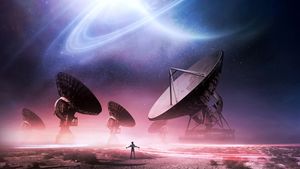August 15, 2020: Difference between revisions
m (Fixed typo. Added link.) |
(A bit more.) |
||
| Line 7: | Line 7: | ||
I have done some work on Zemeckis’ film ''[[w:Contact (1997 American film)|Contact]]'' back in the day, but I have never read [[w:Contact (novel)|Sagan’s novel]]. Obviously an oversight, so I started it today. I can’t believe it was published in 1985, and I equally can’t believe that I didn’t read it in high school. | I have done some work on Zemeckis’ film ''[[w:Contact (1997 American film)|Contact]]'' back in the day, but I have never read [[w:Contact (novel)|Sagan’s novel]]. Obviously an oversight, so I started it today. I can’t believe it was published in 1985, and I equally can’t believe that I didn’t read it in high school. | ||
My [[Toward a Science Fiction Epic|treatment of the film]] was that it contained the '''epic spirit''': it was an example of the epic as science fiction. Here, Ellie Arroway is the [[The Epic Hero|scientist/hero]] | My [[Toward a Science Fiction Epic|treatment of the film]] was that it contained the '''epic spirit''': it was an example of the epic as science fiction. Here, Ellie Arroway is the [[The Epic Hero|scientist/hero]]. The book begins with her birth, education, and early trials—mostly in proving herself in a male-dominated field. Science has become the new language of myth in the latter half of the twentieth century, displacing religion. In fact, Ellie attends bible study as a child at the request of her mother, but it made little rational sense to her. She’d rather fix old vacuum-tube radios and calculate 𝜋. | ||
I’m up to the point where they discover the alien radio transmission from Vega. I guess Sagan was going for verisimilitude, but if I have one criticism, it’s a bit heavy on the math/radio astronomy details. | |||
I continue to work my way through [[w:Ibram X. Kendi|Kendi]]’s ''[[w:How to be an Antiracist|How to be an Antiracist]]''. I’m up to where I’m supposed to be for our next book club meeting on August 25, and I have an idea for a journal entry about it. Maybe tomorrow. | I continue to work my way through [[w:Ibram X. Kendi|Kendi]]’s ''[[w:How to be an Antiracist|How to be an Antiracist]]''. I’m up to where I’m supposed to be for our next book club meeting on August 25, and I have an idea for a journal entry about it. Maybe tomorrow. | ||
Revision as of 08:29, 16 August 2020
Contact covid-19: day 158 | US: GA | info | act
Perusing science fiction for the Kindle, I scored two books: Carl Sagan’s Contact and Sisters of the Revolution: A Feminist Speculative Fiction Anthology a collection of short stories edited by Ann and Jeff VanderMeer. Both for under $5.
(Have I mentioned how much I really enjoy reading on my Kindle Peperwhite? Especially after installing my favorite font, Alegreya? The compulsory ads are stupid—like Amazon needs to do this, but the actual reading experience is excellent.)
I have done some work on Zemeckis’ film Contact back in the day, but I have never read Sagan’s novel. Obviously an oversight, so I started it today. I can’t believe it was published in 1985, and I equally can’t believe that I didn’t read it in high school.
My treatment of the film was that it contained the epic spirit: it was an example of the epic as science fiction. Here, Ellie Arroway is the scientist/hero. The book begins with her birth, education, and early trials—mostly in proving herself in a male-dominated field. Science has become the new language of myth in the latter half of the twentieth century, displacing religion. In fact, Ellie attends bible study as a child at the request of her mother, but it made little rational sense to her. She’d rather fix old vacuum-tube radios and calculate 𝜋.
I’m up to the point where they discover the alien radio transmission from Vega. I guess Sagan was going for verisimilitude, but if I have one criticism, it’s a bit heavy on the math/radio astronomy details.
I continue to work my way through Kendi’s How to be an Antiracist. I’m up to where I’m supposed to be for our next book club meeting on August 25, and I have an idea for a journal entry about it. Maybe tomorrow.
